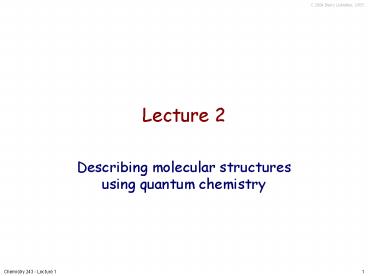Describing molecular structures using quantum chemistry - PowerPoint PPT Presentation
1 / 22
Title:
Describing molecular structures using quantum chemistry
Description:
Lecture 2 Describing molecular structures using quantum chemistry Methane Methane Structure VESPR theory predicts a tetrahedral structure. Why? – PowerPoint PPT presentation
Number of Views:136
Avg rating:3.0/5.0
Title: Describing molecular structures using quantum chemistry
1
Lecture 2
- Describing molecular structures using quantum
chemistry
2
Methane
- Major component of natural gas
- Simplest hydrocarbon
- CH4
- Draw Lewis and Kekulé structures for methane
- How can we draw the molecular bonding orbitals?
3
Methane Structure
- VESPR theory predicts a tetrahedral structure.
Why? - Experimental evidence confirms this stucture.
- Molecular orbitals are mathematical functions
dependant on the exact position of nuclei. - We are not computers, so there is a simple method
for estimating shapes of simple molecular
orbitals in simple molecules.
4
Orbitals Needed
- Carbon
- 2S, 2Px, Py and Pz
- 4 Hydrogens
- 4 x 1S
5
Geometry Conundrum
- The H atoms are 104? apart
- The p-orbitals are 90? apart
- How can I avoid trigonometry?
- Answer Do all trigonometry in advance.
6
Dependency on Angle
- The 1S orbital of the hydrogen with overlap with
the 2S and the 2Px,y,z orbitals of carbon
- Bonding Orbital is
AX Cos(fx)
7
Dependency on Angle
Orbital combination is dependant on the angle of
the two orbitals w.r.t. their axes of mutual
symmetry
Cosine (0?) 1 or maximum
Cosine (90?) 0 or minimum
Cosine (some other angle) some number between 1
and 0 (in between)
8
Thats a Lot of Math
- Lets simplify.
- Let us combine all the terms for the carbon
atomic orbitals in advance. - We will create a new orbital from the combination
of fractions of the 4 atomic orbitals in play. - This new atomic orbital will be called an SP3
orbital - Made from fractions of an S and 3 P orbitals
9
Combining an SP3 Orbital
A1
A2
A3
A4
10
The SP3 Orbital
- 4 atomic orbitals
- S, Px ,Py ,Pz
- Combine to make 4 hybrid atomic orbitals
- 4 x SP3
- Each SP3 alignes with axes of C-H covalent bonds
- We created them for that very purpose
11
Hybridization Summary
12
Addition and Subtraction
13
Orbital Combination
14
Combining Orbitals
C-H antibonding MOs
Hydrogen 1S AOs
CarbonS and Px,y,z AOs
C-H bonding MOs
15
Combining Orbitals
C-H antibonding MOs
CarbonSP3 AOs
Hydrogen 1S AOs
C-H bonding MOs
16
Exercise
- Draw the molecular orbital diagram for acetlyene
(C2H2) - Sketch all the atomic orbitals that you would be
combining to make bonding molecular orbitals - Sketch all the molecular bonding orbitals created
from the combinations of the above - Sketch the antibonding orbitals
- Bonus. - Rank the orbitals in energy
- Hint ? molecular orbitals will be the lowest and
highest energy orbitals. ? molecular orbitals
will be in between these two extremes.
- Hand in your work at the start of the next class
period
17
The C-C Covalent Bond
18
The C-H Covalent Bond
19
The C-O Polar Covalent Bond
20
Consider Ethanol
- Red - More e density
- Blue - Less e density
- Observe the C-C, C-O and C-H bonds
- Is the O-H bond polar? Why or why not? Is it
more or less polar than the C-O bond?
21
The Na-Cl Ionic Bond
22
Ionic Bonds
- Bonds with little orbital overlap
- Very little stabilization from sharing electrons
- Stabilization comes from electrostatic attraction
- Occur between atoms of greatly different
electronegativity






























